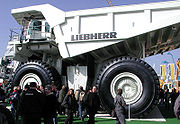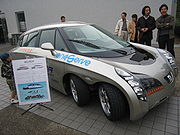
Electronic Differential
Encyclopedia
The main purpose of the electronic differential is to replace the mechanical differential in multi-drive systems, providing the required torque
for each driving wheel and allowing different wheel speeds. When cornering, the inner and outer wheels rotate at different speeds, because the inner wheels describe a smaller turning radius. The electronic differential uses the steering wheel
command signal and the motor
speed signals to control the power to each wheel so that all wheels have the maximum torque they need.
drive train is composed by a single motor
providing torque to one or more driving wheels. The most common solution is to use a mechanical device to distribute torque to the wheels. This mechanical differential allows different wheel speeds when cornering. With the emergence of electric vehicle
s new drive train configurations are possible. Multi-drive systems become easy to implement due to the large power density of electric motor
s. These systems, usually with one motor per driving wheel, need an additional top level controller which performs the same task as a mechanical differential.
The ED scheme has several advantages over a mechanical differential:

 Several applications of this technology have proven successful and have increased vehicle performance. The application range is wide and includes the huge T 282B
Several applications of this technology have proven successful and have increased vehicle performance. The application range is wide and includes the huge T 282B
from Liebherr
which is considered the world largest truck. This earth-hauling truck
is driven by an electric propulsion system composed by two independent electric motors. These motors providing a maximum power of 2700kW are controlled in order to adjust their speeds when cornering, thus increasing traction and reducing tire wear.
The Eliica
is also equipped with electronic differential; this eight-wheeled electric vehicle is capable of driving up to 370km/h whilst maintaining perfect torque control on each wheel. Smaller vehicles for traction purposes and System on Chip controllers for generic vehicular applications are also available.
Torque
Torque, moment or moment of force , is the tendency of a force to rotate an object about an axis, fulcrum, or pivot. Just as a force is a push or a pull, a torque can be thought of as a twist....
for each driving wheel and allowing different wheel speeds. When cornering, the inner and outer wheels rotate at different speeds, because the inner wheels describe a smaller turning radius. The electronic differential uses the steering wheel
Steering wheel
A steering wheel is a type of steering control in vehicles and vessels ....
command signal and the motor
Motor
Motor is a device that creates motion. It usually refers to an engine of some kind. It may also specifically refer to:*Electric motor, a machine that converts electricity into a mechanical motion...
speed signals to control the power to each wheel so that all wheels have the maximum torque they need.
Functional description
The classical automobileAutomobile
An automobile, autocar, motor car or car is a wheeled motor vehicle used for transporting passengers, which also carries its own engine or motor...
drive train is composed by a single motor
Internal combustion engine
The internal combustion engine is an engine in which the combustion of a fuel occurs with an oxidizer in a combustion chamber. In an internal combustion engine, the expansion of the high-temperature and high -pressure gases produced by combustion apply direct force to some component of the engine...
providing torque to one or more driving wheels. The most common solution is to use a mechanical device to distribute torque to the wheels. This mechanical differential allows different wheel speeds when cornering. With the emergence of electric vehicle
Electric vehicle
An electric vehicle , also referred to as an electric drive vehicle, uses one or more electric motors or traction motors for propulsion...
s new drive train configurations are possible. Multi-drive systems become easy to implement due to the large power density of electric motor
Electric motor
An electric motor converts electrical energy into mechanical energy.Most electric motors operate through the interaction of magnetic fields and current-carrying conductors to generate force...
s. These systems, usually with one motor per driving wheel, need an additional top level controller which performs the same task as a mechanical differential.
The ED scheme has several advantages over a mechanical differential:
- simplicity - it avoids additional mechanical parts such as a gearbox or clutchClutchA clutch is a mechanical device which provides for the transmission of power from one component to another...
; - independent torque for each wheel allows additional capabilities (e.g., traction controlTraction control systemA traction control system , also known as anti-slip regulation , is typically a secondary function of the anti-lock braking system on production motor vehicles, designed to prevent loss of traction of driven road wheels...
, stability control); - reconfigurable - it is reprogrammable in order to include new features or tuned according to the driver’s preferences;
- allows distributed regenerative braking;
- the torque is not limited by the wheel with least traction, as it is with a mechanical differential.
- faster response times;
- accurate knowledge of traction torque per wheel.
Applications


Liebherr T 282B
The Liebherr T 282B is an off-highway, ultra class, rigid frame, two-axle, diesel/electric, AC powertrain haul truck designed and manufactured by the Liebherr Mining Equipment Co. in Newport News, Virginia, USA...
from Liebherr
Liebherr
* The Liebherr Group, a German manufacturing complex established in 1949 by Hans Liebherr* Liebherr Grazer AK* Liebherr T 282B, an off- highway, ultra class, rigid frame, two- axle, diesel/electricappointed...
which is considered the world largest truck. This earth-hauling truck
Truck
A truck or lorry is a motor vehicle designed to transport cargo. Trucks vary greatly in size, power, and configuration, with the smallest being mechanically similar to an automobile...
is driven by an electric propulsion system composed by two independent electric motors. These motors providing a maximum power of 2700kW are controlled in order to adjust their speeds when cornering, thus increasing traction and reducing tire wear.
The Eliica
Eliica
The Eliica is a battery electric vehicle prototype or concept car first shown in 2004 and designed by a team at Keio University in Tokyo, led by Professor Hiroshi Shimizu. The car runs on a lithium-ion battery and can accelerate from 0– in four seconds...
is also equipped with electronic differential; this eight-wheeled electric vehicle is capable of driving up to 370km/h whilst maintaining perfect torque control on each wheel. Smaller vehicles for traction purposes and System on Chip controllers for generic vehicular applications are also available.

